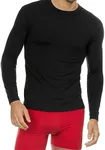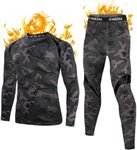Buying Guide for the Best Mens Thermals
When it comes to picking the right men's thermals, it's important to consider a few key factors to ensure you stay warm and comfortable in cold weather. Thermals are designed to provide insulation and wick away moisture, making them essential for layering during winter activities or simply staying cozy indoors. Understanding the different specifications and how they relate to your needs will help you make an informed decision.MaterialThe material of thermals is crucial because it determines the garment's warmth, comfort, and moisture-wicking abilities. Common materials include cotton, wool, and synthetic blends. Cotton is soft and breathable but not the best at wicking moisture. Wool, especially merino wool, is excellent for warmth and moisture management but can be more expensive. Synthetic blends, like polyester or spandex, offer good moisture-wicking properties and durability. Choose a material based on your activity level and how much warmth you need. For high-intensity activities, opt for synthetic blends, while for everyday wear, wool or cotton might be more comfortable.
WeightThermals come in different weights: lightweight, midweight, and heavyweight. Lightweight thermals are best for mild to cool conditions and high-intensity activities where you might sweat more. Midweight thermals provide a balance of warmth and breathability, suitable for moderately cold conditions and a variety of activities. Heavyweight thermals offer maximum warmth and are ideal for extremely cold conditions or low-activity situations. Consider the typical weather conditions you'll be facing and your activity level when choosing the weight of your thermals.
FitThe fit of thermals is important for both comfort and functionality. A snug fit ensures that the thermals can effectively trap body heat and wick away moisture. However, they shouldn't be so tight that they restrict movement or cause discomfort. Look for thermals that offer a close fit without being too constricting. If you plan to layer them under other clothing, make sure they fit comfortably under your outer layers. Trying on different sizes and styles can help you find the best fit for your body type and intended use.
Moisture-WickingMoisture-wicking properties are essential for keeping you dry and comfortable, especially during physical activities. This feature helps to draw sweat away from your skin and allows it to evaporate quickly. Materials like merino wool and synthetic blends are known for their excellent moisture-wicking abilities. If you plan to use your thermals for activities like hiking, skiing, or running, prioritize moisture-wicking properties to prevent discomfort and chills caused by damp fabric.
Odor ResistanceOdor resistance is a valuable feature, particularly if you plan to wear your thermals for extended periods or during strenuous activities. Some materials, like merino wool, naturally resist odors due to their antimicrobial properties. Synthetic materials may also be treated with antimicrobial finishes to prevent odor buildup. If you need thermals for multi-day use or intense activities, look for options with odor-resistant properties to stay fresh and comfortable.
DurabilityDurability is an important consideration, especially if you plan to use your thermals frequently or for outdoor activities. Look for thermals made with high-quality materials and reinforced stitching to ensure they can withstand wear and tear. Synthetic blends tend to be more durable than natural fibers like cotton. Assess your usage patterns and choose thermals that offer the right balance of durability and comfort for your needs.
























